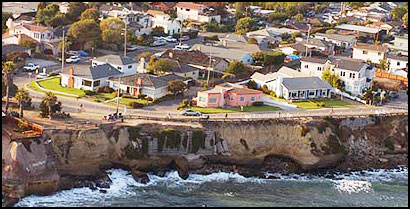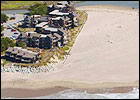
|
 |
 |
The Trouble with Seawalls | by Owen Bailey
" For centuries we have treated the oceans’ bounty as limitless
and beyond our capacity to deplete. We have treated wetlands as wastelands, and
rivers and streams as conduits for our pollution. The evidence of our neglect
and mismanagement is before us. The question now is: What do we do about it?"
-Leon E. Panetta, Washington Post, May 21, 2003
| |
 |
| |
Pleasure Point would receive
“full bluff armoring” if the Army Corps of Engineers and Santa Cruz
County get their way.
 |
The construction of seawalls is one of the most controversial and misunderstood
environmental issues on the California coastline today. Our state is known world-wide
for its graceful and majestic beaches. However, developers and property owners
alike have continued to build far too close to the edge of shoreline bluffs, in
spite of the Coastal Act. As the land under coastal homes, roads and businesses
naturally erodes, one of the most often employed actions is the reinforcing of
the cliff wall. Seawall construction is a major contributor to the disappearance
of the very beaches we all treasure.
Oftentimes, public money is used to protect private structures.
Such steps to protect private property are often taken without consideration of
the public land below. Seawalls and boulders not only diminish public access to
beaches and obliterate pocket beaches, they disrupt the natural processes that
replenish beach sand.
Beaches naturally refresh themselves in several ways. Silt from rivers gets deposited
on the beach, and the crumbling of shoreline cliffs provides a source of new sand.
Dammed and diverted rivers have greatly reduced the amount of sand flowing toward
beaches. Armoring of the coast virtually eliminates the cliffs as a source of
sand and also deprives cliff-nesting birds of essential habitat.
Seawalls multiply with time. As the wall or boulders deflect the waves, embankment
erosion is simply directed to either side of the seawall increasing erosion on
flanking cliffs, where neighboring property owners decide that they too, need
seawalls. Thus the cycle expands.
 |
|
The condos at Pelican Point
are built right on the beach.
 |
|
The California Coastal Act permits the construction of seawalls for “existing
structures.” This wording has created a loophole that has been exploited
to the detriment of our beaches. Coastal construction is currently allowed so
long as the new building is set back sufficiently from the cliff so as to not
require reinforcement for 75 years. However, once the building is erected, it
then can be considered an existing structure and the property owner can then come
back to the Coastal Commission the next year or even the next week and claim that
the erosion situation requires a seawall.
The numbers are worrisome. In 1971, 25 miles of California coast were covered
in shoreline armor. By 1990 (latest data) more than 130 miles of the coast were
encased in seawalls. Thirty percent of the Santa Cruz County coastline is already
hidden behind seawalls.
Oregon, Texas, North and South Carolina and New Jersey ban construction of new
seawalls outright. In California, where 80% of our immense population lives less
than 30 miles from the coast, our seawall policy is tipped toward armoring the
coast. We need legislation to close the loophole in the Coastal Act to stop the
rapid construction of structures that are detrimental to our beaches. The California
Coastal Act intended seawalls to be built as a last resort. The use of seawalls
as our default policy in a vain attempt to control geologic processes has proven
disastrous. We must provide our Coastal Commission with the tools to save our
beaches.
California beaches generate $19 billion/year from tourism and special events.
These beaches must be protected.
[ top of page ]
|
|
 [an error occurred while processing this directive]
[an error occurred while processing this directive]
|

